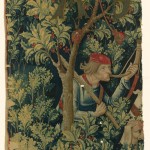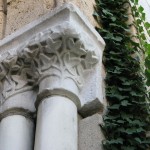Above, from left to right: Detail of holly from The Mystic Capture of the Unicorn; juvenile holly growing in Bonnefont Garden; red-berried holly and black-fruited ivy.
Holy stond in the hall
Faire to behold:
Ivy stond without the dore???
She is ful sore acold.Holy and his mery men
They daunsen and they sing;
Ivy and her maidenes
They wepen and they wring.???Fifteenth-century carol, Reginald Thorne Davies, Medieval English Lyrics: A Critical Anthology, 1972.
A group of English carols set down in the fifteenth century preserves evidence of a ritual contest between boys bearing branches of holly and girls bearing ivy. The red-berried holly, symbolizing light, warmth, and light, was meant to prevail over the black-fruited ivy, which signified the dark and cold of winter. Thus, ivy remained outside the door while holly was carried triumphantly into the hall.
Of all the plants associated with the medieval celebration of Christmastide, holly (Ilex aquifolium) and ivy (Hedera helix) are arguably the most beautiful and the most significant. Both plants had been invested with extraordinary powers in pagan tradition. Holly, native to most parts of south and central Europe, was credited by the Roman natural historian Pliny with the power to protect and defend against witchcraft, lightning, and poison. Ivy was dedicated to Bacchus and was believed to prevent intoxication and confer the power to prophesy. (Maude Grieve, A Modern Herbal, 1971.) By the Middle Ages, holly and ivy had been thoroughly Christianized, although mistletoe remained suspect. Ivy was identified with the Virgin, and the red berries of the holly with the blood of Christ. The holly and ivy carols still sung today spell out the meanings the paired plants bore in the Middle Ages,??while maintaining older associations derived from pre-Christian winter festivals.
More on plants in medieval life and art to come in the New Year.
???Deirdre Larkin
Tags: Hedera helix, holly, Ilex acquifolium, ivy



